#Grey Anteater
Text








Nyctophobia shit, because I'm completely fixated.
#nyctophobia series#nyctophobia#Bazil balloon#Bazilton Bazil Ballooney#boxxie box#Boxxie#Bazil#Haze#Haze Llama#Samm#Samm sock#Grey#Grey anteater#trasheaters ocs#trash eaters ocs#my ocs#ocs#animation#traditional art#digital art#charater design
4 notes
·
View notes
Text


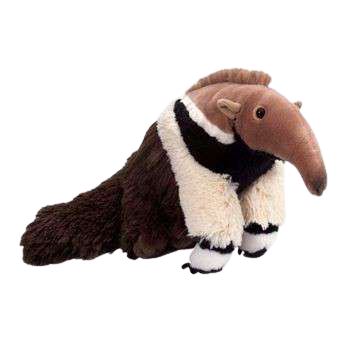
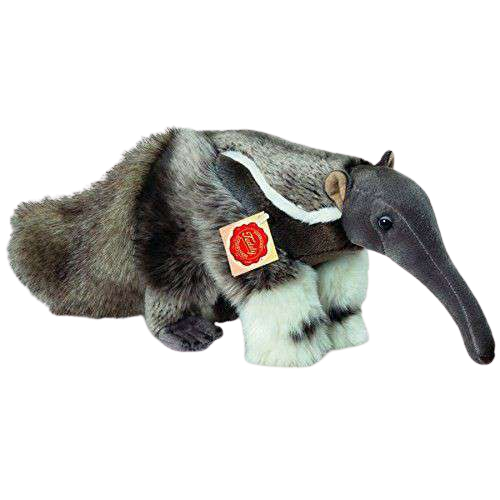
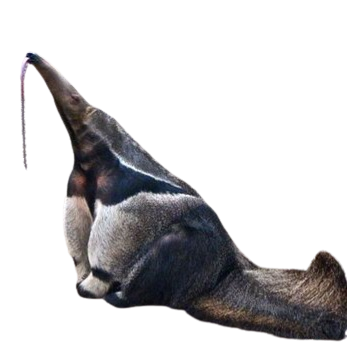
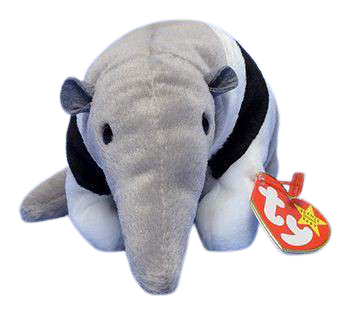
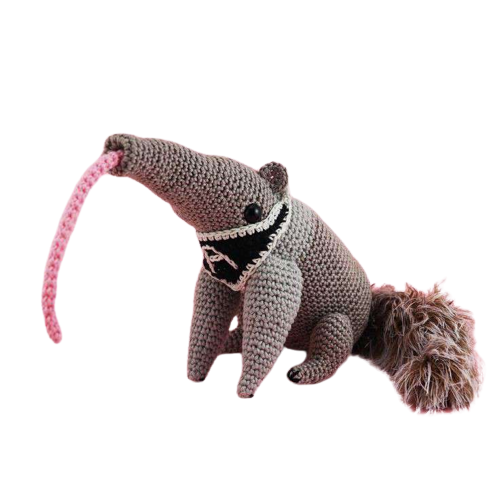
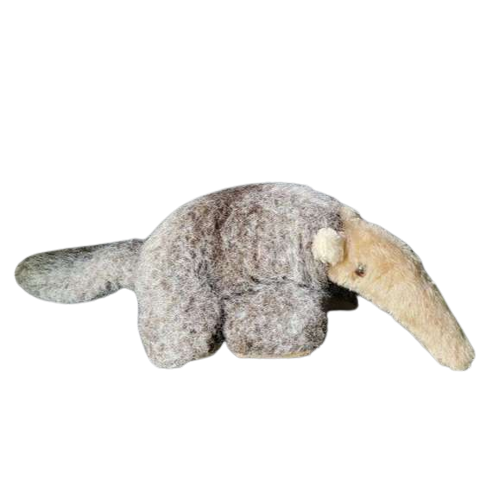
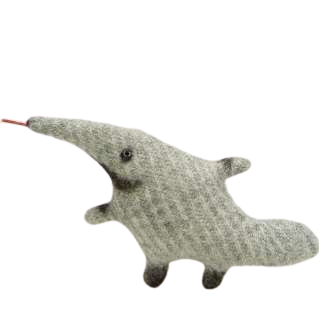

#plushie#cute#agere#age dreaming#age regression#agedre#system little#little#stuffie#stuffed animal#anteater#brown#grey#gray#beanie baby#transparent#png#transparent png
984 notes
·
View notes
Text


>> southern_anteaters_love
67 notes
·
View notes
Text
I have like five fursonas why doesn't anyone ever send me cute or comical videos of those animals with "this you" on the message :(
#admittedly there aren't as many anteater videos as there are like#actually domestic animals#and the cat fursona is a specific cat character not just the generic idea of a cat#(and it's a bit of a grey area whether he counts as a sona or not beyond that i use him representationally)#also the fox fursona is in the same grey boat in that he's representational of a specific character that i connect to#rather than an outright personification of myself#and chickens are more likely to be defaulted to several characters i associate with chickens more#and raccoon videos are in kinda the same boat as anteaters#okay yeah you know what mystery solved actually
2 notes
·
View notes
Text

🍃Create-a-Villager!🍃
i've been really enjoying all of the cas challenges recently, and i've been playing a bunch of animal crossing, so i thought why not combine the two and come up with my own little cas challenge! i hope you guys enjoy and feel free to tag me or use the hastag #createavillager so i can see all of your lovely sims
link to a random number generator!
🍃rolls below the cut🍃
Species (1-35, roll once)
1- alligator
2- anteater
3- bear
4- bird
5- bull
6- cat
7- chicken
8- cow
9- cub
10- deer
11- dog
12- duck
13- egle
14- elephant
15- frog
16- goat
17- gorilla
18- hamster
19- hippo
20- horse
21- kangaroo
22- koala
23- lion
24- monkey
25- mouse
26- octopus
27- ostrich
28- penguin
29- pig
30- rabbit
31- rhino
32- sheep
33- squirrel
34- tiger
35- wolf
Personality (1-8, roll once)
1- normal
2- lazy
3- sisterly
4- cranky
5- jock
6- peppy
7- smug
8- your pick
Colour(s) (1-12, roll as many times as you like)
1- white
2- purple
3- pink
4- red
5- orange
6- yellow
7- green
8- blue
9- cyan
10- brown
11- black
12- grey
Random details (1-23, roll as many times as you like)
1- vitiligo
2- scar(s)
3- freckles
4- glasses
5- bright/bold makeup
6- no makeup
7- hetrochromia
8- thick eyebrows
9- thin eyebrows
10- no eyebrows
11- hat/some sort of head accessory
12- hair tied up
13- short hair
14- medium hair
15- long hair
16- bangs
17- acne
18- birthmark
19- jewellery
20- no jewellery
21- long nails
22- short nails
23- body hair
#i know a ton of people have made cas challenges but i was feeling inspired#createavillger#ts4#ts4 cas#ts4 cas challenge#the sims 4#sims 4#sims 4 cas#sims 4 cas challenge#the sims community#simblr#acnh
182 notes
·
View notes
Text
Today's explorations brought us a couple of new birds. The first one was only today on a technicality, because it was a very wee hour indeed when Valdez let herself into our tent and woke me up to tell me there was a really weird animal outside and she knew I'd want to see it. Kibwana refused to get up, but Reynolds and I followed her to an old log, where we found this:
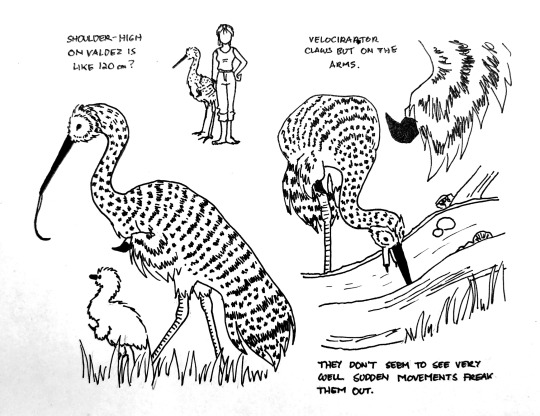
It looks something like a cross between a crane, a grey owl, and an anteater. It and its fluffier offspring were crouched by the log, tilting their heads back and forth to listen, and then they'd lick out with long tongues to catch insects. They didn't seem to need to open their beaks to do this, and I'm not actually sure they could open - I never saw them do so. If the adult needed to pull more of the log apart, it would use the four-inch blunt talon on the end of each otherwise useless wing.
Reynolds says the way the feathers fan out around each eye is actually an adaptation for hearing - it funnels sound into the ears like a radio dish. The adult bird was clearly aware of us and looked directly at us several times, but since we weren't coming any closer it didn't seem bothered as long as we didn't make any sudden movements. Eventually it got its fill of ants and wandered off.
We asked Valdez what she was doing so far from our campsite in the middle of the night. She said she wanted to get further from the fire (which we leave smoldering so the wildlife won't get too nosy) in order to look at the stars. Apparently she's been mapping them. She's even invented several constellations based on tools and animals. I guess we all have our little keep-sane projects.
She was telling me more about it around lunchtime, while the two of us were scrounging for edible plant material, when we got today's second bird. This one was a bastard.
It was very tiny, mostly black on top with an ochre-coloured underside patterned with black v's, and a white mark on the back of its neck. It was also very round with tiny feet and absolutely adorable. I couldn't believe how lucky I was when it landed on my arm and put its beak right up against my skin. I figured it was licking up sweat for salt or something. I was wrong.

After a second or two I realized a bead of blood was forming where it touched me, and when I took a closer look I saw that it actually had a very long, needle-like upper beak that had gone right into my skin without me even feeling it, and a very short lower beak that it opened to let its little tongue lap up the blood. I'm sure I took this in for just a split second, but it felt like I stared at for an hour, unable to move. The image is burned into my retinas. I keep seeing it when I close my eyes.
I hollered and shook it off me, and it flew away. Boonmee put some alcohol on the puncture and told me to watch it carefully for signs of infection. Other than that there's not a lot I can do but wait and see how many diseases the little bugger gave me.
We took several suggestions for the name of the vampire bird, but seem to have settled on Reynolds', which was White-Naped Syrinx. 'Syrinx' is a character from Greek mythology and also the root word from which we get 'syringe'. It is also apparently the word for a bird's voice box. This would be much more interesting to me if I didn't have a hole in my arm.
Somebody suggested calling the anteater bird an owlvark, but Vandebeek said 'aardvark' means 'earth pig' in Dutch, so a more accurate name would be 'aarduil'. When somebody writes a bestiary for this future, we now know what the first page will be.
#the last humans#speculative evolution#aarduil#white-naped syrinx#mariposa valdez#peter przybylski#yes the aarduil is inspired by my friend the mononykus#dunno why i picked this up again i guess i just wanted to draw creeshurs
66 notes
·
View notes
Text
Community-building Tag Game
Tagged by: @anchored-trident
Name: Internet safety 101, kids. Keep 'em guessing. ('Tea' is fine.)
Pronouns: he/him
Where do you call home?
Northwest Canada! Nice and grey.
Favorite animal:
Honestly I love pretty much all of them but if I had to, like. Cohabitate with one? Cats. God's favourite bastards. Also partial to polyphemus moths, the common brown bat, june beetles, golden moles, the silky tree anteater, poison dart frogs, hawks, chimney swifts, and nautuluses, too.
Cereal of choice:
I am. Not a cereal person. Fruit loops?
Are you a visual, auditory, or kinesthetic learner?
Visual. 100%. Everything I do and use is organized by color. I will remember your birthmarks and tattoos and piercings and scars long before I remember your name or anything else about you. I forgot my own name once. It's bad
First pet:
A big black cat.
Favorite scent:
Oh, this is hard. I have a coconut shampoo that reminds me of my mom, and a white musk and oud perfume that makes me think of Cairo, and a plum/vanilla/white musk lotion that smells like the last week of school before summer vacation. A bottle of my dad's cologne he let me keep for my 16th birthday. Frankincense. Lilacs. Sunscreen. Cedarwood. Pine chips. Pumpkin. Clean laundry. I dont think I can pick just one.
Do you believe in astrology?
Not even a little bit. Sure is fun, tho!
How many playlists do you have on Spotify/Apple Music?
Playlists in general? Too many. Couple dozen, probably. One for every occasion.
Sharpies or highlighters?
Sharpies. Though I use highlighters more.
A song that makes you cry:
Right now? "Dear Fellow Traveller" by Sea Wolf. Also "Cain" by Cousin Marnie.
A song that makes you happy:
"Art Hoe" by Call Me Karizma, "Cannibal" by Naethan Apollo, "Wanted To" by Infected Mushroom, and "Daywalker!" By Machine Gun Kelly X CORPSE.
And finally, do you write/draw/create? if so, use this as an opportunity to shamelessly (😉) promote yourself!
I love to draw and oaint and sculpt and sew, but spend a lot of time at work and have some issues with hypersomnia so it doesn't happen as much as I'd like. Wish I could promote myself better because I miss creating but... I don't know. Maybe I'll make something in the morning.
@anchored-trident thanks for the nom'! ♡ This one was fun :)
Nominations (either because we're mutuals or I find you interesting): @melancholysage @naamahdarling @sternenhimmel-mondnhimmel-mond @mist-the-wannabe-linguist @smlmsworld @mangotarot @genderfuckedpigeon @twofaced-gemini-withnobrush
100 notes
·
View notes
Text
Giant Anteater - Myrmecophaga tridactyla


The giant anteater is the largest out of the four species of anteater (the other three being the silky anteater, the northern tamandua, and the southern tamandua). This species is found mostly in grasslands, savanas, and rainforests ranging from the Honduras in Central America to the Gran Chaco region of Bolivia in South America. They tend to forage in open areas and rest in forested areas. During warmer seasons they are mostly nocturnal but will forage during the day when it is cooler. Giant anteaters are typically solitary creatures, mainly only coming together for breeding and when raising young.
The giant anteater has a typical body length of around 6 feet to 7 feet long (182 to 217 cm). Male and females weigh similarly, with females weighing slightly less. Their average weight range is from 60 to 110 lbs (27 to 50 kg). The head of the giant anteater is elongated with a cylindrical snout, making it perfect for reaching in and out of ant hills. Their tongue is approximately 2 feet long and extremely specialized, only moving forwards and backwards. This anteater has thick, bushy, and coarse grey-brown fur and white front legs with black ringed wrists and hands, and dark hind legs. From the throat to the shoulders is a thick black mark with white outlines and sharp tips. Their tail is extremely bushy and often used as a blanket or to shade them from the sun. Similar to apes like the chimpanzee, the giant anteater walks on its knuckles. This helps to keep their claws sharp for digging into ant mounds or for defense.
As their name implies, the giant anteater primarily feeds on ants, although it also feeds on termites. Their long tongue, which they use to feed, has small backward-pointing spines called papillae covered in sticky saliva that aid in feeding. Using its strong sense of smell, which is over 40 times as powerful as a human’s, the giant anteater detects ant mounds. It then digs into the mound before feeding, its tongue darting inside up to 150 times a minute. The anteater then rubs its tongue against its palate to smash the insects for swallowing.
All information is from Wikipedia and [here]. Images sources come from [here] and [here].
46 notes
·
View notes
Text

This week's Bestiary Posting creature is the Dulyamra. I think I have an idea of what general type of animal this could be, but that really doesn't narrow things down, so consider me in the dark for this one.
Things we do know: it can walk upright, but the wording seems to imply they get tired of walking upright, so they can probably move between bipedalism and quadpedelism; it has arms with which it can carry it's baby; every part of it is 'foul', but especially it's rear; it has compressed nostrils, and it's 'hideous' face is like a bellows.
The first big clue is the fact that it can walk upright. There's not a lot of animals that do that - well, aside from birds, but birds can't carry things in their arms so they don't count. My first thought was perhaps drawing a bear-like animal, but then I remembered that giant sloths could walk upright, and it makes a bit more sense for a sloth to carry it's young in it's arms then for a bear to. Plus, sloths already look like they would be sort of foul (my apologies to sloths - but things do actually grow on their fur, which for most animals would be pretty gross). For it's 'hideous' compressed face my thought went to bulldogs and other bracychephalic dogs, but drawing the wrinkles made me think of animals like the hooded seal who have fleshy nose sacks they can inflate, and since that fit in with the idea of their nose being a 'bellows', I opted to give them their own inflatable nasal cavity. To convey it's 'foulness' I emphasized it's shaggy grey coat, making sure it's back end was especially matted looking. I decided to give it the coloration of an anteater since anteaters are close relatives of the sloth, and it's just a fun pattern. Lastly, I decided to depict it not with twins, but with a younger baby being carried, while an older one clings to the mother's shoulders. This is something I've seen with primates - with younger babies being carried, and older, stronger babies clinging to the mother's back.
20 notes
·
View notes
Text

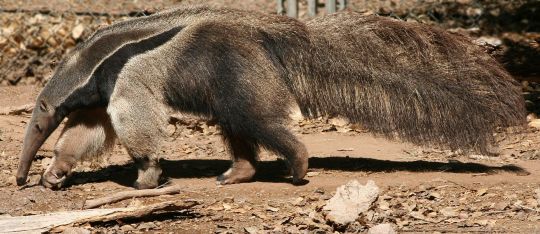
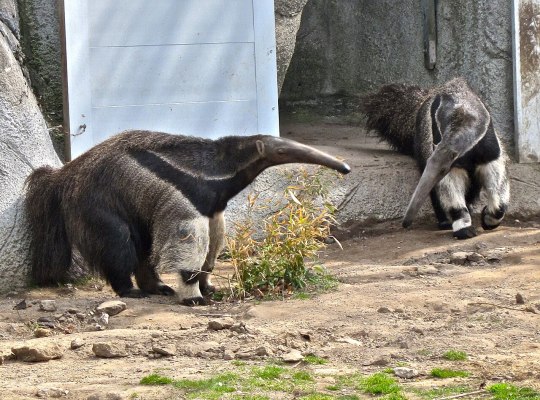
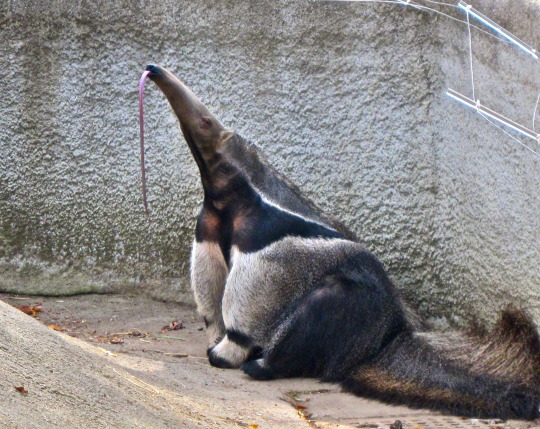
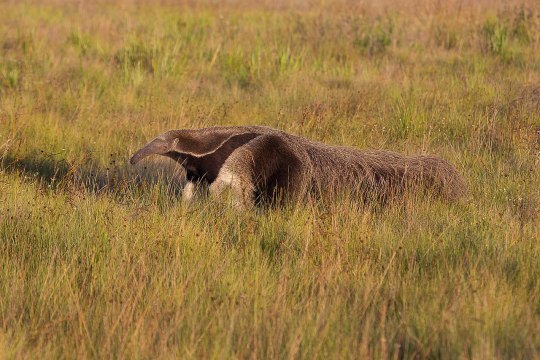



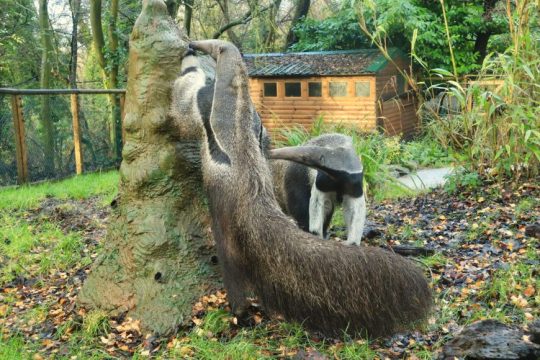

The giant anteater is an insectivorous mammal in the genus Myrmecophaga which is native to Central and South America from as far north as Honduras to as far south as Argentina. Here they generally solitary animals which inhabit rainforests, dry forests, grasslands, and shrublands, and feed primarily upon ants, termites, beetles and there larvae, and honey bees using there long, flexible, sticky tongue. Reaching some 6 to 7ft (182 to 217cms) in length and 60 to 110lbs (27 to 50kg) in weight, the giant anteater is by far the largest of the 4 species of anteater alive today. It is also tied for the position as extant xenarthran only being rivaled by the giant armadillo. The giant anteater has a very distinctive appearance, with a long, tubular snout, small eyes and ears, stocky limbs, long powerful claws, a coarse mane, and a thick bushy tail. They also have a characteristic pattern across their bodies; white front legs, a grey muzzle and a black strip across their chest, throat and shoulders, with bristly, black to brown tails and manes. Mating occurs year round, when two meet up to mate they perform courtship rituals spend several days to weeks mating, traveling, and foraging together. in each other's company to forage. After a 190 day pregnancy a mother will give birth to a single pup; newborns climb onto their mother's back and are carried around by her for the first few weeks of their life. They begin to eat ants and termites at 3 months old and are fully weaned by 10-months. At this age they will leave their mother and become independent, under ideal conditions a giant anteater will reach sexual maturity at 2.5 to 4 years old and may live up to 30.
#pleistocene#pleistocene pride#pliestocene pride#cenozoic#pliestocene#ice age#stone age#giant anteater#anteater#xenarthran
37 notes
·
View notes
Text
youtube
Kaboom.
#nyctophobia#nyctophobia series#voice actors needed#artists needed#artisits on tumblr#indie#indie animation#animated series#trasheaters ocs#my ocs#trash eaters ocs#ocs#boxxie box#bazil balloon#haze llama#samm sock#grey anteater
3 notes
·
View notes
Text

[ Image: A digital pen drawing of my ocs Daybriar and Herb in underclothing, getting ready for a bath. Daybriar is a short, pale skinned fairy woman with redness on her cheeks and shoulders. She has short red thicker textured straight hair with bangs swept to the side, a flat, spade shaped nose, freckles on her cheeks, a paunchy stomach, and bird's feet and legs from the knees down. She is wearing a grey-white undershirt that buttons over her flat chest and plain underwear, and is holding a grey towel under one arm and a bar of light green soap in her other hand. Herb is a light green perlsine, an amphibious creature with a long, anteater-like snout, round yellow eyes on either side of his head, a round body, and a long tail that ends in a round ball. He has green-yellow, thin textured hair cut into a bouncy shoulder-length bob, and is wearing peach button-closed shorts that wrap over the entirety of his stomach and cut off above the knee alongside a pair of spectacles with orange lenses balanced on his snout and a round green ring on his tail. His chest is bare and flat with no nipples. He is standing with a slight smile at the end of his snout and his gaze pointed off-screen. Between the two drawings, there is a small drawing of a nude Daybriar sitting in a large, shallow wooden tub filled with steaming water, hunched over on herself and looking at the water quietly. Behind her, Herb is poised to pour a bucket of water over her head with a sweet look on his face and a towel wrapped around his middle.]
Daybriar and Herb are two scholars in the scholarly city of Gloommond who were both raised with larger families, but act a lot different than each other. Daybrair is a changeling raised in a human farmer's family with many siblings, including her 'twin' after she had been returned. She is a lot more introverted than the rest of her family, and enjoys doing things alongside others but not actively interacting with them, finding her words and actions lacking if she doesn't have a lot of time to think about them first.
Herb is a freshwater perlsine raised in a large family in a basin underneath a cliff, with a close family that was relatively isolated from other people. He enjoys doing things with others, including things that seem to cross boundaries that others seem obvious. Unfortunately, this means he has a hard time reading social cues, so his various ways of interacting (such as pranks or randomly cutting into conversations) that seemed fine within his family are seen as rude in this new environment.
16 notes
·
View notes
Note
Is your guy a Hyena? Just a small question (cuz it's so funny. I'm an anteater, @raccoon-in-a-dumpster is well: a raccoon. And your (probably) a Hyena. And it's so silly how they kinda share the same-ish colors. Gbdvecrbtb)

i am!!
an anteater is awesome!
i love the color grey so i made him grey
10 notes
·
View notes
Text
All animal species (and a couple algae) that have kept the same scientific name since Linnaeus
The first work of taxonomy that is considered as having any scientific authority for animal species was the 10th edition of Linnaeus' Systema Naturae, published in 1758. (Also a book on spiders called Aranei Suecici, published one year before.) That's the foundational text of the binominal system of nomenclature of species still in use today. Since then most of Linnaeus' original species (4379 species, of which 185 mammals, 554 birds, 217 "amphibians" (including reptiles and cartilaginous fish), 379 fishes, 2104 "insects" (including various arthropods, of which 664 are beetles and 543 are moths & butterflies crammed into only 3 genera), and 940 "worms" (including basically all other invertebrates, and even some protists and algae)) have been dismembered, renamed, or at least moved to different genera (e.g. the house sparrow went from Fringilla domestica to Passer domesticus).
Here is a list of all of Linnaeus' original species from 1758 that still retain their original name. I believe they are 484 in total.
"Mammalia"
(Primates)
Homo sapiens (human)
Lemur catta (ring-tailed lemur)
Vespertilio murinus (rearmouse bat)
(Bruta)
Elephas maximus (Asian elephant)
Trichechus manatus (West Indian manatee)
Bradypus tridactylus (three-toed sloth)
Myrmecophaga tridactyla (giant anteater)
Manis pentadactylus (Chinese pangolin)
(Ferae)
Phoca vitulina (harbor seal)
Canis familiaris (dog)
Canis lupus (grey wolf)
Felis catus (house cat)
Viverra zibetha (Indian civet)
Mustela erminea (stoat)
Mustela furo (ferret)
Mustela lutreola (European mink)
Mustela putorius (wild ferret)
Ursus arctos (brown bear)
(Bestiae)
Sus scrofa (wild boar/pig)
Dasypus septemcinctus (seven-banded armadillo)
Dasypus novemcinctus (nine-banded armadillo)
Erinaceus europaeus (European hedgehog)
Talpa europaea (European mole)
Sorex araneus (common shrew)
Didelphis marsupialis (common opossum)
(Glires)
Rhinoceros unicornis (Indian rhinoceros)
Hystrix brachyura (Malayan porcupine)
Hystrix cristata (crested porcupine)
Lepus timidus (common hare)
Castor fiber (European beaver)
Mus musculus (house mouse)
Sciurus vulgaris (red squirrel)
(Pecora)
Camelus dromedarius (dromedary camel)
Camelus bactrianus (Asian camel)
Moschus moschiferus (musk deer)
Cervus elaphus (red deer)
Capra hircus (goat)
Capra ibex (Alpine ibex)
Ovis aries (sheep)
Bos taurus (cow)
Bos indicus (zebu)
(Belluae)
Equus caballus (horse)
Equus asinus (donkey)
Equus zebra (mountain zebra)
Hippopotamus amphibius (hippopotamus)
(Cete)
Monodon monoceros (narwhal)
Balaena mysticetus (bowhead whale)
Physeter macrocephalus (sperm whale)
Delphinus delphis (common dolphin)
"Aves"
(Accipitres)
Vultur gryphus (Andean condor)
Falco tinnunculus (common kenstrel)
Falco sparverius (sparrowhawk)
Falco columbarius (pigeonhawk)
Falco subbuteo (Eurasian hobby)
Falco rusticolus (gyrfalcon)
Strix aluco (tawny owl)
Lanius excubitor (great grey shrike)
Lanius collurio (red-backed shrike)
Lanius schach (long-tailed shrike)
(Picae)
Psittacus erithacus (grey parrot)
Ramphastos tucanus (white-throated toucan)
Buceros bicornis (great hornbill)
Buceros rhinoceros (rhinoceros hornbill)
Crotophaga ani (smooth-billed ani)
Corvus corax (raven)
Corvus corone (carrion crow)
Corvus frugilegus (rook)
Corvus cornix (hooded crow)
Coracias oriolus (golden oriole)
Coracias garrulus (European roller)
Gracula religiosa (hill myna)
Paradisaea apoda (greater bird-of-paradise)
Cuculus canorus (common cuckoo)
Jynx torquilla (wryneck)
Picus viridis (green woodpecker)
Sitta europaea (Eurasian nuthatch)
Merops apiaster (European bee-eater)
Merops viridis (blue-throated bee-eater)
Upupa epops (Eurasian hoopoe)
Certhia familiaris (Eurasian treecreeper)
Trochilus polytmus (red-billed streamertail hummingbird)
(Anseres)
Anas platyrhynchos (mallard duck)
Anas crecca (teal duck)
Mergus merganser (common merganser)
Mergus serrator (red-breasted merganser)
Alca torda (razorbill auk)
Procellaria aequinoctialis (white-chinned petrel)
Diomedea exulans (wandering albatross)
Pelecanus onocrotalus (great white pelican)
Phaeton aethereus (red-billed tropicbird)
Larus canus (common gull)
Larus marinus (great black-backed gull)
Larus fuscus (lesser black-backed gull)
Sterna hirundo (common tern)
Rhynchops niger (black skimmer)
(Grallae)
Phoenicopterus ruber (American flamingo)
Platalea leucorodia (Eurasian spoonbill)
Platalea ajaia (roseate spoonbill)
Mycteria americana (wood stork)
Ardea cinerea (grey heron)
Ardea herodias (blue heron)
Ardea alba (great egret)
Scolopax rusticola (Eurasian woodcock)
Charadrius hiaticula (ringed plover)
Charadrius alexandrinus (Kentish plover)
Charadrius vociferus (killdeer plover)
Charadrius morinellus (Eurasian dotterel)
Recurvirostra avosetta (pied avocet)
Haematopus ostralegus (Eurasian oystercatcher)
Fulica atra (Eurasian coot)
Rallus aquaticus (water rail)
Psophia crepitans (grey-winged trumpeter)
Otis tarda (great bustard)
Struthio camelus (ostrich)
(Gallinae)
Pavo cristatus (Indian peafowl)
Meleagris gallopavo (wild turkey)
Crax rubra (great curassow)
Phasianus colchicus (common pheasant)
Tetrao urogallus (western capercaillie)
(Passeres)
Columba oenas (stock dove)
Columba palumbus (wood pigeon)
Alauda arvensis (Eurasian skylark)
Sturnus vulgaris (European starling)
Turdus viscivorus (mistle thrush)
Turdus pilaris (fieldfare thrush)
Turdus iliacus (redwing thrush)
Turdus plumbeus (red-legged thrush)
Turdus torquatus (ring ouzel)
Turdus merula (blackbird)
Loxia curvirostra (crossbill)
Emberiza hortulana (ortolan bunting)
Emberiza citrinella (yellowhammer)
Emberiza calandra (corn bunting)
Fringilla coelebs (common chaffinch)
Motacilla alba (white wagtail)
Motacilla lava (yellow wagtail)
Parus major (great tit)
Hirundo rustica (barn swallow)
Caprimulgus europaeus (European nightjar)
"Amphibia"
(Reptiles)
Testudo graeca (Greek tortoise)
Draco volans (flying dragon)
Lacerta agilis (sand lizard)
Rana temporaria (common frog)
(Serpentes)
Crotalus horridus (timber rattlesnake)
Crotalus durissus (tropical rattlesnake)
Boa constrictor (common boa)
Coluber constrictor (eastern racer)
Anguis fragilis (slowworm)
Amphisbaena alba (red worm lizard)
Caecilia tentaculata (white-bellied caecilian)
(Nantes)
Petromyzon marinus (sea lamprey)
Raja clavata (thornback ray)
Raja miraletus (brown ray)
Squalus acanthias (spiny dogfish)
Chimaera monstrosa (rabbitfish)
Lophius piscatorius (anglerfish)
Acipenser sturio (sea sturgeon)
Acipenser ruthenus (sterlet sturgeon)
"Pisces"
(Apodes)
Muraena helena (Mediterranean moray)
Gymnotus carapo (banded knifefish)
Trichiurus lepturus (cutlassfish)
Anarhichas lupus (Atlantic wolffish)
Ammodytes tobianus (lesser sandeel)
Xiphias gladius (swordfish)
Stromateus fiatola (blue butterfish)
(Jugulares)
Callionymus lyra (common dragonet)
Uranoscopus scaber (stargazer)
Trachinus draco (greater weever)
Gadus morhua (Atlantic cod)
Blennius ocellaris (butterfly blenny)
Ophidion barbatum (snake cusk-eel)
(Thoracici)
Cyclopterus lumpus (lumpsucker)
Echeneis naucrates (sharksucker)
Coryphaena equiselis (pompano)
Coryphaena hippurus (dorado)
Gobius niger (black goby)
Govius paganellus (rock goby)
Cottus gobio (European bullhead)
Scorpaena porcus (black scorpionfish)
Scorpaena scrofa (red scorpionfish)
Zeus faber (John Dory)
Pleuronectes platessa (European plaice)
Chaetodon striatus (banded butterflyfish)
Chaetodon capistratus (foureye butterflyfish)
Sparus aurata (gilt-head bream)
Labrus merula (brown wrasse)
Labrus mixtus (cuckoo wrasse)
Labrus viridis (green wrasse)
Sciaena umbra (brown meagre)
Perca fluviatilis (European perch)
Gasterosteus aculeatus (three-spined stickleback)
Scomber scombrus (Atlanti mackerel)
Mullus barbatus (red mullet)
Mullus surmuletus (surmullet)
Trigla lyra (piper gurnard)
(Abdominales)
Cobitis taenia (spined loach)
Silurus asotus (Amur catfish)
Silurus glanis (Wels catfish)
Loricaria cataphracta (suckermouth catfish)
Salmo carpio (Garda trout)
Salmo trutta (brown trout)
Salmo salar (Atlantic salmon)
Fistularia tabacaria (bluespotted cornetfish)
Esox lucius (northern pike)
Argentina sphyraena (European argentine)
Atherina hepsetus (Mediterranean sand smelt)
Mugil cephalus (flathead mullet)
Exocoetus volitans (tropical flying fish)
Polynemus paradiseus (Paradise threadfin)
Clupea harengus (Atlantic herring)
Cyprinus carpio (common carp)
(Branchiostegi)
Mormyrus caschive (bottlenose elephantfish)
Balistes vetula (queen triggerfish)
Ostracion cornutus (longhorn cowfish)
Ostracion cubicus (yellow boxfish)
Tetraodon lineatus (Fahaka pufferfish)
Diodon hystrix (spot-fin porcupinefish)
Diodon holocanthus (long-spine porcupinefish)
Centriscus scutatus (grooved shrimpfish)
Syngnathus acus (common pipefish)
Syngnathus pelagicus (pelagic pipefish)
Syngnathus typhle (broad-nosed pipefish)
Pegasus volitans (longtail seamoth)
"Insecta"
(Coleoptera)
Scarabaeus sacer (sacred scarab)
Dermestes lardarius (larder beetle)
Dermestes murinus (larder beetle)
Hister unicolor (clown beetle)
Hister quadrimaculatus (clown beetle)
Silpha obscura (carrion beetle)
Cassida viridis (tortoise beetle)
Cassida nebulosa (tortoise beetle)
Cassida nobilis (tortoise beetle)
Coccinella trifasciata (ladybug)
Coccinella hieroglyphica (ladybug)
[Coccinella 5-punctata, 7-punctata, 11-punctata, and 24-punctata survive as quinquepunctata, septempunctata, undecimpunctata, and vigintiquatorpunctata]
Chrysomela populi (leaf beetle)
Chrysomela lapponica (leaf beetle)
Chrysomela collaris (leaf beetle)
Chrysomela erythrocephala (leaf beetle)
Curculio nucum (nut weevil)
Attelabus surinamensis (leaf-rolling weevil)
Cerambyx cerdo (capricorn beetle)
Leptura quadrifasciata (longhorn beetle)
Cantharis fusca (soldier beetle)
Cantharis livida (soldier beetle)
Cantharis oscura (soldier beetle)
Cantharis rufa (soldier beetle)
Cantharis lateralis (soldier beetle)
Elater ferrugineus (rusty click beetle)
Cicindela campestris (green tiger beetle)
Cicindela sylvatica (wood tiger beetle)
Buprestis rustica (jewel beetle)
[Buprestis 8-guttata survives as octoguttata]
Dytiscus latissimus (diving beetle)
Carabus coriaceus (ground beetle)
Carabus granulatus (ground beetle)
Carabus nitens (ground beetle)
Carabus hortensis (ground beetle)
Carabus violaceus (ground beetle)
Tenebrio molitor (mealworm)
Meloe algiricus (blister beetle)
Meloe proscarabaeus (blister beetle)
Meloe spec (blister beetle)
Mordela aculeata (tumbling glower beetle)
Necydalis major (longhorn beetle)
Staphylinus erythropterus (rove beetle)
Forficula auricularia (common earwig)
Blatta orientalis (Oriental cockroach)
Gryllus campestris (field cricket)
(Hemiptera)
Cicada orni (cicada)
Notonecta glauca (backswimmer)
Nepa cinerea (water scorpion)
Cimex lectularius (bedbug)
Aphis rumici (black aphid)
Aphis craccae (vetch aphid)
Coccus hesperidum (brown scale insect)
Thrips physapus (thrips)
Thrips minutissimum (thrips)
Thrips juniperinus (thrips)
(Lepidoptera)
Papilio paris (Paris peacock butterfly)
Papilio helenus (red Helen butterfly)
Papilio troilus (spicebush swallowtail butterfly)
Papilio deiphobus (Deiphobus swallowtail butterfly)
Papilio polytes (common Mormon butterfly)
Papilio glaucus (eastern tiger swallowtail butterfly)
Papilio memnon (great Mormon butterfly)
Papilio ulysses (Ulysses butterfly)
Papilio machaon (Old World swallowtail butterfly)
Papilio demoleus (lime swallowtail butterfly)
Papilio nireus (blue-banded swallowtail butterfly)
Papilio clytia (common mime butterfly)
Sphinx ligustri (privet hawk-moth)
Sphinx pinastri (pine hawk-moth)
[genus Phalaena was suppressed, but seven subgenera created by Linnaeus are now valid as genera]
(Neuroptera)
Libellula depressa (chaser dragonfly)
Libellula quadrimaculata (four-spotted skimmer dragonfly)
Ephemera vulgata (mayfly)
Phryganea grandis (caddisfly)
Hemerobius humulinus (lacewing)
Panorpa communis (scorpionfly)
Panorpa germanica (scorpionfly)
Raphidia ophiopsis (snakefly)
(Hymenoptera)
Cynips quercusfolii (oak gall wasp)
Tenthredo atra (sawfly)
Tenthredo campestris (sawfly)
Tenthredo livida (sawfly)
Tenthredo mesomela (sawfly)
Tenthredo scrophulariae (sawfly)
Ichneumon extensorius (parasitoid wasp)
Ichneumon sarcitorius (parasitoid wasp)
Sphex ichneumoneus (digger wasp)
Vespa crabro (European hornet)
Apis mellifera (honey bee)
Formica fusca (silky ant)
Mutilla europaea (large velvet ant)
(Diptera)
Oestrus ovis (sheep botfly)
Tipula oleracea (marsh cranefly)
Tipula hortorum (cranefly)
Tipula lunata (cranefly)
Musca domestica (housefly)
Tabanus bovinus (pale horsefly)
Tabanus calens (horsefly)
Tabanus bromius (brown horsefly)
Tabanus occidentalis (horsefly)
Tabanus antarcticus (horsefly)
Culex pipiens (house mosquito)
Empis borealis (dance fly)
Empis pennipes (dance fly)
Empis livida (dance fly)
Conops flavipes (thick-headed fly)
Asilus barbarus (robberfly)
Asilus crabroniformis (hornet robberfly)
Bombylius major (bee fly)
Bombylius medius (bee fly)
Bombylius minor (bee fly)
Hippobosca equina (forest fly)
(Aptera)
Lepisma saccharina (silverfish)
Podura aquatica (water springtail)
Termes fatale (termite)
Pediculus humanus (human louse)
Pulex irritans (human flea)
Acarus siro (flour mite)
Phalangium opilio (harvestman)
Araneus angulatus (orb-weaving spider)
Araneus diadematus (European garden spider)
Araneus marmoreus (marbled orbweaver)
Araneus quadratus (four-spotted orbweaver -- last four are by Clerck 1757, some of the very few surviving pre-Linnean names!)
Scorpio maurus (large-clawed scorpion)
Cancer pagurus (brown crab)
Oniscus asellus (common woodlouse)
Scolopendra gigantea (giant centipede)
Scolopendra morsitans (red-headed centipede)
Julus fuscus (millipede)
Julus terrestris (millipede)
"Vermes"
(Intestina)
Gordius aquaticus (horsehair worm)
Lumbricus terrestris (common earthworm)
Ascaris lumbricoides (giant roundworm)
Fasciola hepatica (liver fluke)
Hirudo medicinalis (medicinal leech)
Myxine glutinosa (Atlantic hagfish)
Teredo navalis (shipworm)
[shout out to Furia infernalis, a terrifying carnivorous jumping worm that Linnaeus described, but which doesn't seem to actually exist]
(Mollusca)
Limax maximus (leopard slug)
Doris verrucosa (warty nudibranch)
Nereis caerulea (ragworm)
Nereis pelagica (ragworm)
Aphrodita aculeata (sea mouse)
Lernaea cyprinacea (anchor worm)
Scyllaea pelagica (Sargassum nudibranch)
Sepia officinalis (common cuttlefish)
Asterias rubens (common starfish)
Echinus esculentus (edible sea urchin)
(Testacea)
Chiton tuberculatus (West Indian green chiton)
Lepas anatifera (goose barnacle)
Pholas dactylus (common piddock)
Mya arenaria (softshell clam)
Mya truncata (truncate softshell)
Solen vagina (razor clam)
Tellina laevigata (smooth tellin)
Tellina linguafelis (cat-tongue tellin)
Tellina radiata (sunrise tellin)
Tellina scobinata (tellin)
Cardium costatum (ribbed cockle)
Donax cuneatus (wedge clam)
Donas denticulatus (wedge clam)
Donax trunculus (wedge clam)
Venus casina (Venus clam)
Venus verrucosa (warty venus)
Spondylus gaederopus (thorny oyster)
Spondylus regius (thorny oyster)
Chama lazarus (jewel box shell)
Chama gryphoides (jewel box shell)
Arca noae (Noah's ark shell)
Ostrea edulis (edible oyster)
Anomia aurita (saddle oyster)
Anomia ephippium (saddle oyster)
Anomia hysterita (saddle oyster)
Anomia lacunosa (saddle oyster)
Anomia spec (saddle oyster)
Anomia striatula (saddle oyster)
Mytilus edulis (blue mussel)
Pinna muricata (pen shell)
Pinna nobilis (fan mussel)
Pinna rudis (rough pen shell)
Argonauta argo (argonaut)
Nautilus pompilius (chambered nautilus)
Conus ammiralis (admiral cone snail)
Conus aulicus (princely cone snail)
Conus aurisiacus (cone snail)
Conus betulinus (betuline cone snail)
Conus bullatus (bubble cone snail)
Conus capitaneus (captain cone snail)
Conus cedonulli (cone snail)
Conus ebraeus (black-and-white cone snail)
Conus figulinus (fig cone snail)
Conus genuanus (garter cone snail)
Conus geographus (geographer cone snail)
Conus glaucus (glaucous cone snail)
Conus granulatus (cone snail)
Conus imperialis (imperial cone snail)
Conus litteratus (lettered cone snail)
Conus magus (magical cone snail)
Conus marmoreus (marbled cone snail)
Conus mercator (trader cone snail)
Conus miles (soldier cone snail)
Conus monachus (monastic cone snail)
Conus nobilis (noble cone snail)
Conus nussatella (cone snail)
Conus princeps (prince cone snail)
Conus spectrum (spectrecone snail)
Conus stercusmuscarum (fly-specked cone snail)
Conus striatus (striated cone snail)
Conus textile (cloth-of-gold cone snail)
Conus tulipa (tulip cone snail)
Conus varius (freckled cone snail)
Conus virgo (cone snail)
Cypraea tigris (tiger cowry shell)
Bulla ampulla (Pacific bubble shell)
Voluta ebraea (Hebrew volute)
Voluta musica (music volute)
Buccinum undatum (common whelk)
Strombus pugilis (fighting conch)
Murex tribulus (caltrop murex)
Trochus maculatus (maculated top shell)
Turbo acutangulus (turban shell)
Turbo argyrostomus (silver-mouth turban shell)
Turbo chrystostomus (gold-mouth turban shell)
Turbo marmoratus (green turban shell)
Turbo petholatus (turban shell)
Turbo sarmaticus (giant turban shell)
Helix lucorum (Mediterranean snail)
Helix pomatia (Roman snail)
Nerita albicilla (blotched nerite)
Nerita chamaeleon (nerite)
Nerita exuvia (snakeskin nerite)
Nerita grossa (nerite)
Nerita histrio (nerite)
Nerita peloronta (bleeding tooth)
Nerita plicata (nerite)
Nerita polita (nerite)
Nerita undata (nerite)
Haliotis asinina (ass-ear abalone)
Haliotis marmorata (marbled abalone)
Haliotis midae (South African abalone)
Haliotis parva (canaliculate abalone)
Haliotis tuberculata (green ormer)
Haliotis varia (common abalone)
Patella caerulea (Mediterranean limpet)
Patella pellucida (blue-rayed limpet)
Patella vulgata (European limpet)
Dentalium elephantinum (elephant tusk)
Dentalium entale (tusk shell)
[genus Serpula is still in use with none of its original species]
(Lithophyta)
Tubipora musica (organ pipe coral)
Millepora alcicornis (sea ginger fire coral)
Madrepora oculata (zigzag stone coral)
(Zoophyta)
Isis hippuris (sea bamboo)
Isis ochracea (sea bamboo)
Gorgonia flabellum (Venus fan)
Gorgonia ventalina (purple sea fan)
Alcyonium bursa (soft coral)
Alcyonium digitatum (dead man's fingers)
Tubularia indivisa (oaten ipes hydroid)
Corallina officinalis (coralline red alga)
Sertularia argentea (sea fern)
Sertularia cupressoides (hydroid)
Pennatula phosphorea (sea pen)
Taenia solium (pork tapeworm)
Volvox globator (colonial alga)
[genus Hydra is still in use with none of its original species]
15 notes
·
View notes
Text

Zootopia 2 Hopes & Predictions
With Zootopia 2 announced, I wanna share some things I want to see, some things I would love to see but don't think will be shown, some things I don't want to see, and some other predictions.
• Unrealistic Hopes
- Bogo and Clawhauser confirmed as/becoming a couple
- Bucky and Pronk directly confirmed as husbands in canon (and not just hinted at)
- Reptiles and avians
- Nick is bi
- Jack Savage
- Finnick speaking roles (since his voice actor, Tommy Lister Jr., passed away in 2020)
- Jack Black voicing a panda as a clear nod to Kung Fu Panda but the character has absolutely no similarity to Po other than species
- Some sort of reference/nod to The Bad Guys
• Wants
General
- More Gideon Grey
-- More of Gideon's new relationship with Stu and Bonnie
- Learning Mrs. Otterton's first name
- Learning Bogo's first name
-- Learning Bogo's backstory
- More Mr. Manchas
- Nick's family
- Mr. Otterton speaking role
- Explanation as to how sloths function in a society like this
- Judy Big (Fru Fru's child)
- More Sam (the otter from Zootopia+)
- Lore of Zootopia's founding
- Canon confirmation that predators get their necessary meat-based proteins from insect-based foods
- Continued inclusion of adult-based humor
- Michael Giacchino doing the score again
Characters & Species
[Note: I know some of these species are already included in Zootopia 1 but I just wanna see more of those]
- More rabbits and foxes as characters in the background
- Deer
- Bears (that aren't polar bears)
- Equines
- Hares
- Goats
- Cows & Bulls
- Guinea pigs
- Llamas
- Camels
- Bison
- Hyenas
- Ferrets
- Uncommon* mammals (capybaras, chinchillas, anteaters, African wild dogs, meerkats, etc.)
- Nice sheep
- Tiger side character (with a speaking role)
[* Uncommon in terms of typical animal-based things]
Locations
- More Bunnyburrow (especially the towns & buildings)
- Judy's home
- Deeper exploration into Sahara Square
- Deeper exploration into the Rainforest District
- Places (like Bunnyburrow) that are around Zootopia but not actually part of it
- Shadier, seedier underground-type places
- A mall
- A movie theater
- More of the museum
- Spaces built mainly for large mammals like elephants and rhinos, as a sort of contrast to Little Rodentia
• Unwants
- Humans in any capacity
- Deaths (especially of main characters like Nick and side characters like Judy's parents, Finnick, or Gideon)
- Gideon becoming antagonistic again
- Nick and Judy somehow having kids
- More copoganda
- Chris Pratt voicing a character
- James Corden voicing a character
- Any reference to bitcoin/NFTs
- Any use of AI-generated art or voices
• Maybe-wants?
[I'm on the fence about whether I'd like to see these or not]
- Explanation as to how domestic dogs and cats exist in this universe (which they do, or at least cats)
- Explanation as to why there are no avians, reptiles, or marine mammals
- Some inclusion of the scrapped shock-collar plotline
- Explanation as to how ice cream is made
- Lore of Zootopia's universe (like how animals evolved to become sapient and anthropomorphic)
• Predictions
- Nick and Judy will have another falling out but will get back together
- Bogo and Clawhauser will be heavily included again
- Bonnie and Stu will be side characters again
- Finnick will be seen but won't have any sort of major role
- The story won't be as good or topical as the first but the writing will be on-par
- The story will be set either very soon after the first movie or a couple years later; it won't be too far in the future.
- Nick and Judy will remain cops at the end of the movie
- Zootopia+ will be referenced at least once
- Flash will appear again
Sorry for the long post, I'm just thinking about the possibilities a lot.
I'd love to hear your opinions, wants, predictions, etc.!
#zootopia 2#zootopia#zootropolis#zootopia+#disney#zootopia sequel#sequel#predictions#judy hopps#nick wilde#gideon grey#jack savage#flash slothmore#bogo#chief bogo#benjamin clawhauser#zootopia sam#bonnie hopps#stu hopps#finnick#mr. otterton#mr. manchas#renato manchas#mod post#long post#long
84 notes
·
View notes
Note
Get to know me ask: 🍕😳💙🐷
🍕 - What’s the last thing you ate? Lu Rou Fan (Taiwanese Braised Pork Belly) at the Taiwanese restaurant in the next town over from us.
😳 - Do you like your name? I suppose so? I could not imagine my name as anything else tbh!
💙 - What colour is your bedroom? The walls are white, or off-white I suppose, whatever the previous owner painted it.
🐷 - What’s your favourite animal? It is hard to pick just one because I love SO MANY animals, but the grey wolf is probably my all time favorite! My spirit animal, if you will. Second is cats, of course, lol! I also love red pandas, pangolins, African wild dogs, Pallas cats, box turtles, cicadas, isopods, and giant anteaters!
Get To Know Me Ask Game!
2 notes
·
View notes